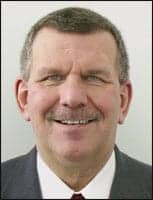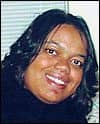
|
| Retired Cleveland police officer Jim Cudo, right, was inspired to face his hearing loss in order to enhance time spent with his granddaughter Courtney, left. |
Forty years ago, when Jim Cudo was a young patrolman in the Cleveland Police Department, noise protection at the indoor practice shooting range was a simple matter. “We would stick 38 caliber bullets in our ears—didn’t use muffs, even if they had them,” Cudo recalled. “It was foolish, but it was something we did.”
Although over the years he experienced some hearing difficulties, it was in the past 5 years that Cudo, now 62, had good reason to regret his youthful bravado, as he began to suffer significant high-frequency hearing loss. “My granddaughter, Courtney, who is now 11, and I would play a game in which she was the teacher and I was the student, and she’d ask me questions. A lot of times I would say to her, ‘I can’t hear you, honey,’ and I’d have to ask her to repeat the questions she was asking me. She would get upset or frustrated, and I could see it.”
Cudo says that it was because of the frustration he felt about his inability to hear his granddaughter that he decided to have his hearing tested for the second time. “About 3 years ago, I tested the first time and learned that I had hearing loss, that I couldn’t hear high-pitched voices. It was recommended that I get hearing aids.”
But at that time Cudo succumbed to the typical male attitude about wearing hearing aids—”I started the procedure of getting hearing aids, then decided I wasn’t going to do that. It was a guy thing—I just wasn’t going to have those things behind my ear, in my ear, whatever. You listen to stories from some people who have hearing aids; they say they can’t hear, everything is jumbled. They had even started to make the molds when I backed off. I never really gave it a chance, and I should have.”
But then came a change of heart. “I decided I just had to do this because of the growing trouble I was having hearing my wife and granddaughter, and because of my hearing loss in general,” he said.
Cudo was referred by his ear, nose, and throat doctor to another audiologist, and within the past 6 months was fitted for Siemens hearing aids. “I went back again and brought my wife, Linda, with me so she could be part of the process.” In a few weeks, Cudo had his Siemens Life 700 BTE hearing aids.
In reflecting on the first day he used his hearing aids, Cudo recalls, “That was the best part, because now I was able to really hear. As an example, if I went to a grocery store, I could hear a cart behind me, even the wheels turning, which I couldn’t do before. The sound of running water was much clearer to me. And most importantly, I could hear my wife and granddaughter.
“Prior to that,” he says, “because I couldn’t hear, I would just sit there and not partake in discussions. Sometimes I’d make foolish statements because I couldn’t hear, so I would shut myself down. I didn’t feel good about myself. There’s a lot of emotional distress involved. Hearing loss makes you feel isolated.”
Now, hearing everyday things such as birds and traffic “is just a great experience,” Cudo says. Also, after retiring from the police force, Cudo began working as a process server. The job involves a lot of driving and door-to-door visits, making hearing traffic and people in the street crucial. “Good hearing could be something that saves my life,” he says.
During his recent 40th wedding anniversary celebration, he could hear his whole family despite the noise around them at a local restaurant. “It’s a different world, and it has made me feel good.”
RESISTANCE IS FUTILE
Cudo’s story is not unusual. As Tom Powers, vice-president of Audiology and Compliance at Siemens, puts it, “Jim is one of many folks we’ve encountered through our dispensers who typically resist for a while, then finally make it into the hearing aid family.”
Because many hearing-impaired people wait a long time before seeking help, and as an inquiry into the various factors involved in hearing loss, Siemens conducted a survey to study the “disconnect” between the hearing-impaired person and their children, wherein the parent is less likely to recognize the need for hearing aids than their child. In May 2009, a San Francisco independent study group surveyed 500 older Americans, age 50-75, and their children, and found that while 30% of the parents acknowledged hearing problems, more than twice that percentage—70% to 72%—of the children believed their parent was hearing impaired. This result was based on perception, not testing. “People often perceive their hearing to be better than it is,” says Powers. “It’s not me, it’s them, is a typical viewpoint.”

|
| Tom Powers |
In Cudo’s case, notes Powers, “You have the prototypical guy who’s had this noise exposure at a shooting range for 10 to 15 years, then really begins to feel the hearing loss later in life, and eventually overcomes his resistance and takes appropriate action.”
Commenting on Cudo’s particular hearing aid model, Powers says that the BTE type constitutes about 55% of the market. “BTEs are becoming very popular because the newer models, such as the Life 700 with its open fit silicon dome, eliminate occlusion (that ‘stuck-in-the-ear’ sensation). The open fit leaves the ear canal open from an acoustic standpoint so that low-frequency sounds can vent, thus preventing occlusion.” Also, the model goes a way toward combating the aesthetic stigma of hearing aids by having a very thin and clear tubing that goes from the BTE unit into the ear. “The tubing is barely visible, so cosmetically, it’s an advance,” adds Powers.
Cudo himself says the model is not only small and unobtrusive but also very light, “so that I hardly know I have it on,” and his concern about embarrassment is “completely gone.”
Powers points out that Cudo’s noise-induced hearing loss is of the moderate high-frequency type that is typical of most hearing loss. “In speech, the high-frequency sounds are the consonants, whereas the vowels are low frequency. The consonants give understanding. Thus, with this type of loss, it’s hard to tell what ‘kind’ is it from what ‘time’ is it, and so on. This can create a lot of confusion and distress.”
For Cudo, the distress is history. His words, “I am so happy that I ended up getting hearing aids,” say it all. “To hear Courtney say, ‘My papa can hear me better now,’ is a beautiful feeling for me. I will talk about it to anybody because if I can help somebody else discover that hearing aids can definitely help them, that’s why I’m doing what I’m doing.”
When it comes to researching this issue, the National Institute for Occupational Safety and Health (NIOSH) is quite involved in studying the effects of noise-induced hearing loss, as well as making recommendations to reduce the hazards.
At the NIOSH office in Cincinnati, Ohio, William Murphy, PhD, co-team leader for hearing loss prevention, and Chuck Kardous, Division of Applied Research and Technology, have performed health hazard evaluations that have demonstrated that the best way to prevent weapons training hearing loss is by wearing double protection, that is, combined earplugs and earmuffs.
“When we’re out in the field making assessments,” says Murphy, “we see quite a range of usage. Some officers do use the recommended double protection, but others use single and often ill-fitting protection. We are definitely promoting double protection for law enforcement, which runs a high risk because of the many rounds shot at firing ranges.
“The best combination,” says Murphy, “is a deeply inserted foam earplug and a well-seated earmuff.” He adds, “Special care must be taken to ensure the earmuff remains sealed against the side of the wearer’s head when safety glasses are worn.”
In an evaluation reported by Murphy and Randy L. Tubbs, PhD, of tests conducted at the Fort Collins Police Services in Colorado, NIOSH investigators determined that “a potential health hazard does exist for officers because the noise levels produced by their weapons are sufficient to put them at risk for occupational hearing loss.” However, the report concluded, the Fort Collins Police Services does seem to offer adequate hearing protection “as evidenced by the lack of TTS [Temporary Threshold Shift] following a qualification course with pistols, shotguns, and rifles, and by the normal hearing thresholds measured in nearly all of the officers.”
Specifically, the noise measurements for the various weapons ranged from 159 to 169 dB peak, which is greater than the 140 dB peak exposure guideline from NIOSH. “The peak reductions afforded by the ear plugs, ear muffs, and customized SWAT team hearing protectors were all in the 30 dB range. Double hearing protection (plugs plus muffs) added 15 to 20 dB more of peak reduction.”
The study concluded that “Officers should wear hearing protection whenever they are at the firing ranges,” and furthermore, “the department should research new hearing protection devices that incorporate radio communications into the device and are still compatible with other protection devices such as helmets and glasses.”
NIOSH strongly recommends that “Employers and firing range operators should take steps to protect their workers and shooters from exposure to hazardous noise levels at indoor firing ranges. Those in need of protection include thousands of employees at the firing ranges as well as more than a million federal, state, and local law officers who train regularly at these facilities. In addition to workers, 20 million active target shooters are potentially exposed to noise hazards at indoor firing ranges.”1
A hearing protection device (HPD) manufacturer that subscribes to NIOSH’s double protection recommendation is Westone, Colorado Springs, Colo. For maximum protection on the firing range, Westone recommends “a pair of solid custom earplugs combined with a set of quality ear-muff style over-the-ear HPDs.” Its own “No. 40 earpieces in OtoBlast provide an NPR (Noise Power Ratio) of 29 dB, while the muffs add about another 6 dB.” “Beyond that,” the company adds, “not much can be done as the noise is transferred through bone conduction.”
As well as for the firing range, Westone also offers devices appropriate for work in the field, including the Westone Style No. 47. “These earpieces allow verbal communication, but will also protect against high noise levels that may be encountered such as vehicle sirens, road noise, etc.” Another offering for law enforcement is the style No. 32 custom communication earpiece, which, “when ordered with either no vent or a tiny pressure vent, can provide officers with both radio communications capability and hearing protection.”
Murphy concludes with a personal account. “I took up deer hunting after moving to the Cincinnati suburbs. The first year I went hunting, I failed to wear any protection on opening day. I shot my shotgun twice that morning and immediately noticed that my ears were ringing. I then resolved to wear hearing protection the next year.
“The following year, I remembered to bring a pair of level-dependent electronic earmuffs. These muffs had low profile ear cups and did not interfere as one fires the shotgun and also allowed me to hear the sounds of the woods around me. I kept my resolution to wear the muffs; however, as it turned out, I was wearing them around my neck when it came time to shoot. As happened the year before, my ears immediately began to ring. Tinnitus or ringing of the ears following an intense noisy activity, such as shooting, is an indication of potential damage of the sensory cells in the inner ear.”
And that’s when Murphy bit the bullet—a far better solution than Cudo’s method of sticking bullets in his ears at the firing range.
“I resolved to never fire a gun again without hearing protection,” Murphy said. “Hearing protection can protect the ears only when it is worn.”
REFERENCE
- NIOSH Publication No. 20009-136, April 2009.
Alan Ruskin is a writer for Hearing Review Products. For more information, send e-mail to [email protected].






